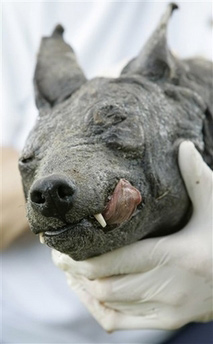Chupacabra is actually a hairless coyote
Chupacabra is actually a hairless coyote
mongabay.com
November 2, 2007
DNA analysis has identified the creature discovered on a Texas ranch as nothing more than a coyote, according to the Associated Press. The animal may have had mange or another sickness or disorder.
This summer the animal carcass caused a stir when a woman promoted the find as a “chupacabra”, a legendary beast said to suck the blood of goats and other livestock. Her claims were criticized by veterinarians and pet owners, many of whom believed the animal to be a sick domestic dog. Nevertheless the woman saved the head of the carcass to allow genetic testing of the beast.

Frozen head of a so-called Chupacabra in Cuero, Texas. (AP Photo/Eric Gay) |
“The DNA sequence is a virtually identical match to DNA from the coyote (Canis latrans),” said Mike Forstner of the biology department at Texas State. “This is probably the answer a lot of folks thought might be the outcome. I, myself, really thought it was a domestic dog, but the Cuero chupacabra is a Texas Coyote.”
“Not often do we have genetic material available from an animal that has been linked to a legendary myth,” Forstner continued. “If people are worried about the chupacabra, it is probably even more important that we explain the mystery. Folks can fear what they don’t understand, and a big part of the goal in science is to explain the natural world.”
“DNA tells a story. It allows us to determine the difference between animal species, and while I thought it was a canid (one of the members in the dog family), I could not tell from the photographs which one it might be,” Forstner added. “From my perspective, we were interested in providing a direct answer from the DNA, testing the best guesses of experts by using the evidence from the animal itself.